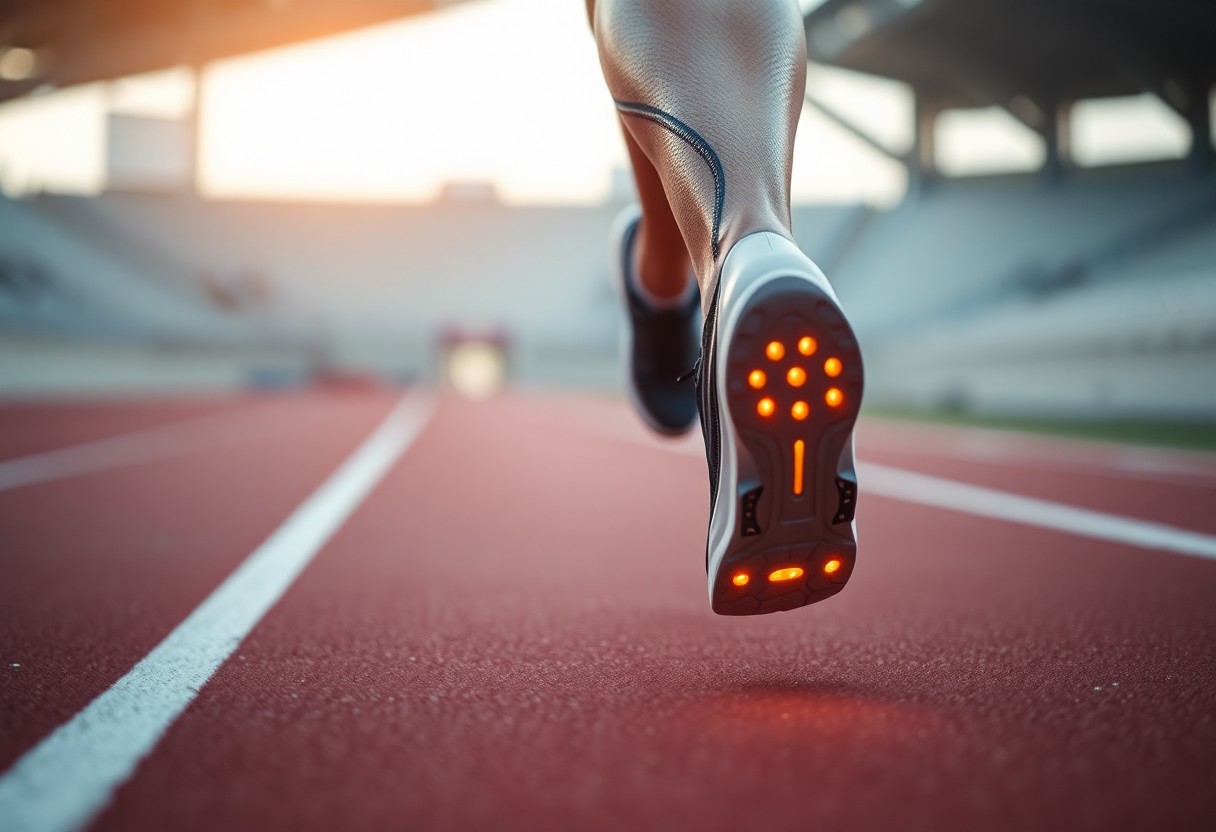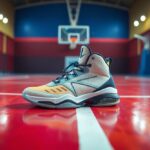
Delve into the revolutionary advancements in running footwear technology that have significantly reshaped the realm of performance optimisation for endurance athletes.
The realm of performance optimisation in endurance running has undergone a remarkable transformation thanks to advanced footwear technology, which offers unparalleled opportunities to enhance your athletic capabilities. You will learn how innovative shoe designs can effectively lower your metabolic expenditure and enhance your running economy. By incorporating carbon fibre plates and state-of-the-art midsole materials, these shoes deliver exceptional energy return mechanisms, potentially reducing your oxygen consumption by up to 4%. Whether you are a seasoned professional or a committed amateur, grasping these biomechanical advancements can empower you to make educated decisions regarding your running gear and optimise your race times.
 Continue reading to gain deeper insights into the mechanics of advanced running footwear that promise to elevate your performance:
Continue reading to gain deeper insights into the mechanics of advanced running footwear that promise to elevate your performance:
Unlocking the Science Behind Energy Return Mechanisms in Advanced Running Shoes
Advanced running shoe technology utilises intricate biomechanical principles to revolutionise the process of energy transfer during locomotion. Innovative design elements collaborate seamlessly to reduce metabolic expenditure, establishing a sophisticated system that enhances running efficiency through meticulous material engineering and geometric configurations. By concentrating on the mechanics of energy return, these shoes provide runners with a substantial advantage in both performance and stamina, enabling prolonged runs with diminished fatigue.
Investigating the Dynamics of Curvature in Carbon Fibre Plates
Carbon fibre plates exploit meticulous geometric engineering to redirect kinetic energy during the running motion. Optimal curvature angles ranging from 12° to 15° facilitate maximum energy storage and return, with finite element modelling showing energy return efficiencies of up to 93% in prototype designs. These meticulously engineered plates create a spring-like mechanism that lessens muscular effort during the toe-off phases, allowing runners to conserve energy over extended distances, thereby improving endurance and overall performance.
Evaluating the Differences Between TPU and EVA in Midsole Innovations
Material selection plays a pivotal role in determining shoe performance, with thermoplastic polyurethane (TPU) emerging as a superior technology for midsoles. Comparative analyses highlight the notable advantages of TPU in terms of energy return and impact absorption, equipping runners with enhanced biomechanical efficiency across diverse running conditions. The decision between TPU and EVA foam is crucial for athletes aiming to maximise their performance while minimising the risk of injuries during both training and competitive events.
| Energy Return | 18% higher in TPU |
| Oxygen Consumption Reduction | 2.4% lower with TPU |
A thorough investigation into midsole materials reveals subtle yet impactful performance characteristics. TPU exhibits superior resilience when compared to traditional EVA foam, maintaining consistent mechanical properties over thousands of compression cycles. Runners benefit from more reliable energy return, reduced fatigue, and enhanced long-distance performance as a result of advanced material science innovations, all of which can significantly influence their overall training outcomes and competition results.
| Impact Absorption | TPU absorbs 37% more force |
| Rebound Elasticity | 89% maintained across 50,000 cycles |
 Explore further as we investigate the impact of advanced footwear technology on metabolic efficiency:
Explore further as we investigate the impact of advanced footwear technology on metabolic efficiency:
Assessing Metabolic Efficiency: Identifying Who Gains the Most from Advanced Footwear
Advanced footwear technology does not yield uniform benefits for all runners. Gains in metabolic efficiency vary considerably among different demographic groups, influenced by factors such as gender, age, and individual biomechanics, which all play critical roles in enhancing performance. Researchers have revealed intricate patterns of metabolic response, showing that the advantages of super shoes extend beyond mere performance metrics, encompassing complex physiological adaptations unique to each runner’s biomechanical profile.
Analysing Gender-Specific Performance Enhancements in Running
Female runners experience a 3.2% improvement in metabolic power, whereas males enjoy a 4.2% improvement, indicating complex neuromuscular adaptations at play. Data on pelvic kinematics indicates a 14% greater reduction in hip adduction angle in females using advanced footwear, which may elucidate the subtle differences in metabolic gains observed between genders. Understanding these variances can assist in tailoring training and footwear selections to optimise performance benefits for each gender.
Investigating Age-Related Benefits and Their Impact on Endurance Performance
Masters athletes aged 40 and above exhibit a 2.8% greater reduction in oxygen cost when utilising super shoes, likely compensating for diminished tendon elasticity. Analysis of tibial loading indicates a 12% cumulative stress reduction per kilometre in older runners, suggesting notable advantages in injury prevention and performance preservation. These findings underscore the significance of advanced footwear technology in prolonging the competitive longevity of older athletes.
The benefits of advanced footwear technology related to age extend well beyond straightforward performance metrics. Biomechanical studies indicate that older runners are subject to more pronounced adaptations due to compensatory mechanisms. Reduced tendon stiffness and altered muscle recruitment patterns interact synergistically with shoe technology to create a unique performance enhancement profile. Specifically, the energy return mechanism provided by the carbon plate appears to counteract age-related biomechanical inefficiencies, potentially extending competitive running careers by alleviating the physiological constraints typically associated with aging athletes.
Continue reading to further explore the implications of advanced footwear technology on injury risks:
Examining the Relationship Between Running Footwear and Injury Risk
Advanced footwear technology introduces intricate biomechanical interactions that necessitate a nuanced analysis of possible injury risks. Runners must thoughtfully weigh the balance between performance enhancement and physiological adaptation. Longitudinal studies reveal subtle yet critical changes in muscular recruitment patterns, joint loading, and proprioceptive feedback occurring when transitioning to high-performance running shoes, underscoring the need for a balanced approach to training and recovery.
Injury Analysis: Evaluating the Risks Associated with Enhanced Performance
Biomechanical research indicates a 9% increase in Achilles tendon strain rates among users of super shoes during high-intensity training. Plantar pressure mapping reveals a 22% increase in forefoot loading when compared to traditional trainers, particularly evident during challenging terrains such as downhill running. These findings suggest that while metabolic efficiency may improve, runners must implement targeted strength and adaptation protocols to mitigate potential injury risks and promote long-term athletic health.
Optimising Training Protocols for Effective Gait Adaptations
Your biomechanical response to advanced footwear necessitates strategic adjustments in your training regimen. Gait retraining is essential to optimise the unique energy return mechanisms of carbon-plated shoes. Runners should concentrate on developing neuromuscular patterns that align with the shoe’s biomechanical design, potentially diminishing injury risk while maximising performance benefits.
Comprehensive gait adaptation strategies require multifaceted approaches to effectively integrate advanced footwear technology. Biomechanical analysis suggests that runners typically require approximately 6 to 8 weeks of progressive training to fully adapt to the unique mechanical properties of super shoes. This period of adaptation should include targeted eccentric strengthening protocols, modified interval training techniques, and careful monitoring of lower limb biomechanics. Professional athletes and dedicated runners can greatly benefit from periodic 3D gait analysis to track subtle changes in movement patterns, ensuring the optimal integration of advanced footwear technology with individual biomechanical characteristics.
 Explore the future of footwear technology and its implications for runners:
Explore the future of footwear technology and its implications for runners:
Anticipating Future Innovations in Running Footwear Technology
Emerging technologies are set to revolutionise the design of running shoes, pushing the boundaries of biomechanical efficiency and performance optimisation. Cutting-edge research is focused on creating personalised solutions that adapt to individual biomechanics, leveraging advanced materials, computational modelling, and integrated sensor technologies to forge a new generation of intelligent footwear designed specifically for elite athletes.
Transforming Footwear Design with 3D Printed Midsoles
Optimisation algorithms for lattice structures now facilitate precise regional stiffness variations that correspond to individual foot pressure maps. Prototype testing reveals that these innovations yield an additional 5.1% in metabolic savings compared to mass-produced models, with computational design enabling unparalleled customisation of midsole geometries to maximise energy return while minimising biomechanical stress. This pioneering approach ensures that each runner can achieve optimal performance tailored to their specific physical characteristics.
Integrating Smart Technology for Enhanced Performance Monitoring
Emerging sensor technologies are evolving running shoes into sophisticated performance tracking devices. Real-time ground reaction force feedback systems have the potential to reduce oxygen consumption by 1.9% through micro-adjustments in cadence, providing runners with immediate biomechanical insights throughout training and competition. These advancements are vital for athletes striving to refine their technique and optimise performance metrics.
Advanced sensor integration signifies a monumental leap in performance monitoring technology. Multi-axis accelerometers, pressure-sensitive matrices, and embedded microprocessors now capture intricate biomechanical data with exceptional precision. These intelligent systems analyse gait mechanics, impact forces, and energy expenditure in real-time, delivering granular insights into runners’ movement patterns. Machine learning algorithms are now capable of predicting potential injury risks, optimising training loads, and suggesting personalised technique modifications based on comprehensive movement analysis, transforming running shoes from passive equipment into active tools for performance optimisation.
Finally, develop a deeper understanding of the transformative landscape shaped by advanced footwear technology in endurance running:
Embracing the Future of Advanced Footwear Technology
In summary, you have examined the transformative landscape of advanced footwear technology in endurance running. Your insights now encompass how innovative design elements such as carbon plates and high-performance midsole materials can substantially decrease metabolic costs and enhance running efficiency. By harnessing scientific insights, you can recognise that these shoes provide far more than mere marginal gains—they represent a significant shift in athletic performance paradigms. Your investment in such advanced technology could lead to improved running economy, diminished energy expenditure, and optimised biomechanical responses across a diverse range of athletic demographics.
The Article Biomechanical Efficiency of Advanced Footwear Technology: Metabolic Cost Reduction and Performance Enhancement in Endurance Running appeared first on My Shoes Finder.
The Article Biomechanical Efficiency in Advanced Footwear for Runners Was Found On https://limitsofstrategy.com







